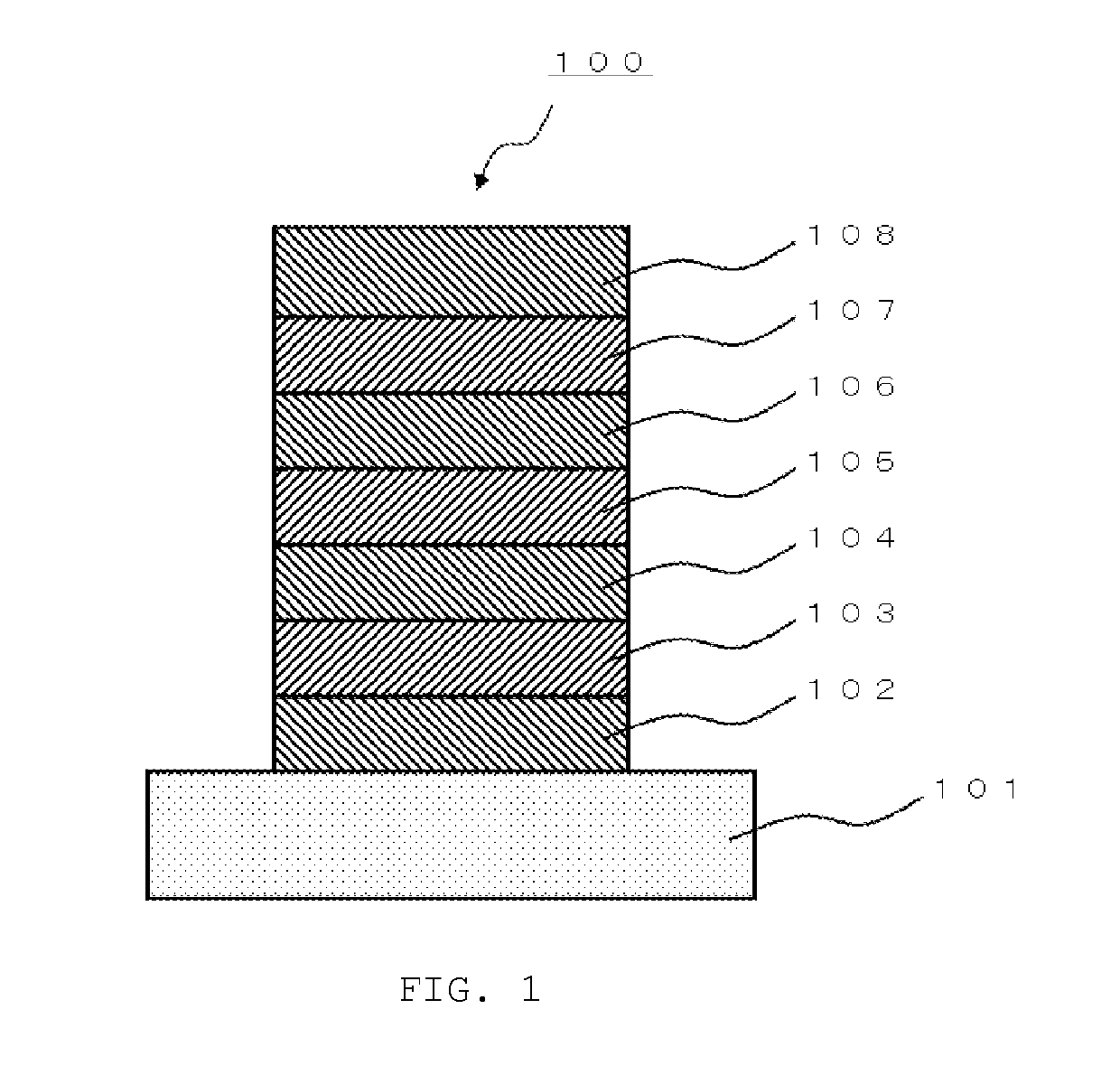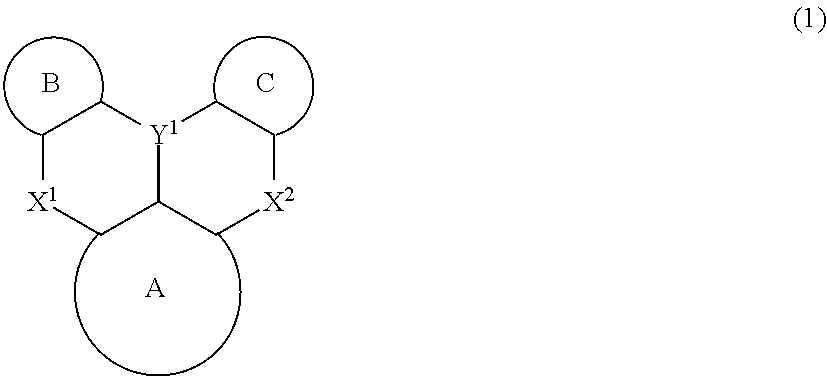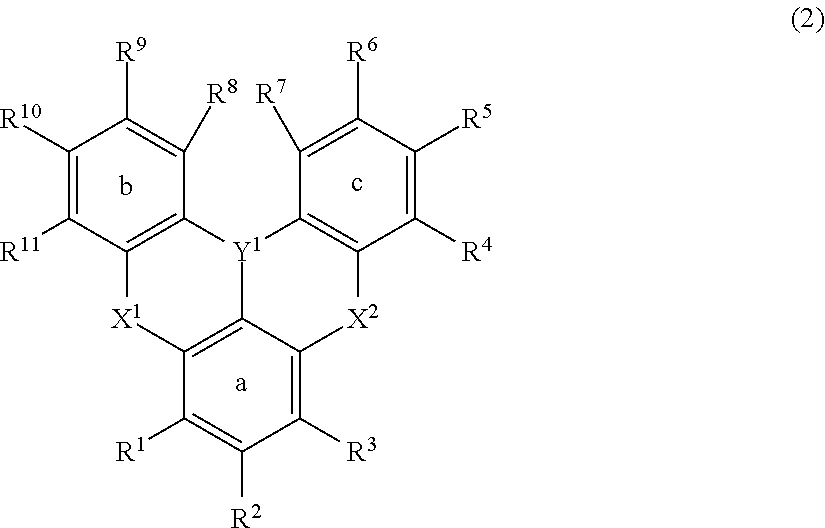Deuterium-substituted polycyclic aromatic compound
a polycyclic aromatic compound and substitute technology, applied in the field of deuterium substitution of polycyclic aromatic compounds, can solve the problems of insufficient lifetime of existing aromatic rings as host materials, insufficient redox stability of aromatic rings having small conjugated systems, and inability to describe a manufacturing method for materials other, etc., to achieve high triplet excitation energy, reduce the homo-luminescence gap, and increase the effect of redox stability
- Summary
- Abstract
- Description
- Claims
- Application Information
AI Technical Summary
Benefits of technology
Problems solved by technology
Method used
Image
Examples
examples
[0411]Hereinafter, the present invention will be described more specifically by way of Examples, but the present invention is not limited thereto. First, a synthesis example of a polycyclic aromatic compound will be described below.
Synthesis Example (1): Synthesis of Compound (1-22)
[0412]
[0413]Under an atmosphere of nitrogen, 3,4,5-trichloroaniline (12.0 g), d5-bromobenzene (30.0 g), dichlorobis[(di-t-butyl (4-dimethylaminophenyl) phosphino) palladium (Pd-132, 0.43 g) as a palladium catalyst, sodium-t-butoxide (NaOtBu, 14.7 g), and xylene (200 ml) were put in a flask and heated at 120° C. for three hours. After a reaction, water and ethyl acetate were added to the reaction solution, followed by stirring. Thereafter, the organic layer was separated and washed with water. Thereafter, the organic layer was concentrated to obtain a crude product. The crude product was purified with a silica gel short pass column (eluent: toluene / heptane=1 / 1 (volume ratio)) to obtain intermediate (I-A) (...
example 1
[0445]
[0446]A glass substrate (manufactured by Opto Science, Inc.) having a size of 26 mm×28 mm×0.7 mm, which was obtained by forming a film of ITO having a thickness of 180 nm by sputtering, and polishing the ITO film to 150 nm, was used as a transparent supporting substrate. This transparent support substrate was fixed to a substrate holder of a commercially available vapor deposition apparatus (manufactured by Sowa Shinku Co., Ltd.). Molybdenum vapor deposition boats containing HI, HAT-CN, HT-1, HT-2, BH-1, compound (1-22), ET-1, and ET-2, respectively, and aluminum nitride vapor deposition boats containing Liq, LiF, and aluminum, respectively, were attached thereto.
[0447]Layers as described below were formed sequentially on the ITO film of the transparent supporting substrate. A vacuum chamber was depressurized to 5×10−4 Pa. First, HI was heated and vapor-deposited so as to have a film thickness of 40 nm. Subsequently, HAT-CN was heated and vapor-deposited so as to have a film t...
example 2
[0452]
[0453]A glass substrate (manufactured by Opto Science, Inc.) having a size of 26 mm×28 mm×0.7 mm, which was obtained by forming a film of ITO having a thickness of 180 nm by sputtering, and polishing the ITO film to 150 nm, was used as a transparent supporting substrate. This transparent support substrate was fixed to a substrate holder of a commercially available vapor deposition apparatus (manufactured by Sowa Shinku Co., Ltd.). Tantalum vapor deposition boats containing HI, HAT-CN, HT-1, HT-2, BH-1, compound (1-222), ET-1, and ET-2, respectively, and aluminum nitride vapor deposition boats containing Liq, LiF, and aluminum, respectively, were attached thereto.
[0454]Layers as described below were formed sequentially on the ITO film of the transparent supporting substrate. A vacuum chamber was depressurized to 5×10−4 Pa. First, HI was heated and vapor-deposited so as to have a film thickness of 40 nm. Subsequently, HAT-CN was heated and vapor-deposited so as to have a film th...
PUM
| Property | Measurement | Unit |
|---|---|---|
| thickness | aaaaa | aaaaa |
| thickness | aaaaa | aaaaa |
| thickness | aaaaa | aaaaa |
Abstract
Description
Claims
Application Information
 Login to View More
Login to View More - R&D
- Intellectual Property
- Life Sciences
- Materials
- Tech Scout
- Unparalleled Data Quality
- Higher Quality Content
- 60% Fewer Hallucinations
Browse by: Latest US Patents, China's latest patents, Technical Efficacy Thesaurus, Application Domain, Technology Topic, Popular Technical Reports.
© 2025 PatSnap. All rights reserved.Legal|Privacy policy|Modern Slavery Act Transparency Statement|Sitemap|About US| Contact US: help@patsnap.com



